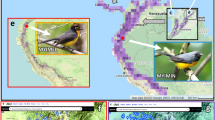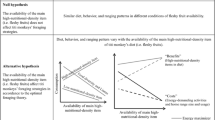Abstract
Little is known as to how visual systems and visual behaviors vary within guilds in which species share the same micro-habitat types but use different foraging tactics. We studied different dimensions of the visual system and scanning behavior of Carolina chickadees, tufted titmice, and white-breasted nuthatches, which are tree foragers that form heterospecific flocks during the winter. All species had centro-temporally located foveae that project into the frontal part of the lateral visual field. Visual acuity was the highest in nuthatches, intermediate in titmice, and the lowest in chickadees. Chickadees and titmice had relatively wide binocular fields with a high degree of eye movement right above their short bills probably to converge their eyes while searching for food. Nuthatches had narrower binocular fields with a high degree of eye movement below their bills probably to orient the fovea toward the trunk while searching for food. Chickadees and titmice had higher scanning (e.g., head movement) rates than nuthatches probably due to their wider blind areas that limit visual coverage. The visual systems of these three species seem tuned to the visual challenges posed by the different foraging and scanning strategies that facilitate the partitioning of resources within this guild.






Similar content being viewed by others
References
Bartmess-LeVasseur J, Branch CL, Browning SA, Owens JL, Freeberg TM (2010) Predator stimuli and calling behavior of Carolina chickadees (Poecile carolinensis), tufted titmice (Baeolophus bicolor), and white-breasted nuthatches (Sitta carolinensis). Behav Ecol Sociobiol 64:1187–1198
Beauchamp G (2003) Group-size effects on vigilance: a search for mechanisms. Behav Process 63:111–121
Blackwell BF, Fernández-Juricic E, Seamans TW, Dolan T (2009) Avian visual system configuration and behavioural response to object approach. Anim Behav 77:673–684
Blumstein DT, Daniel JC (2007) Quantifying behavior the JWatcher way. Sinauer Associates Inc, Sunderland
Carr JM, Lima SL (2012) Heat-conserving postures hinder escape: a thermoregulation—predation trade-off in wintering birds. Behav Ecol 23:434–441
Changizi MA, Shimojo S (2008) ‘‘X-ray vision’’ and the evolution of forward-facing eyes. J Theor Biol 254:756–767
Collin SP (1999) Behavioural ecology and retinal cell topography. In: Archer S, Djamgoz MB, Loew E, Partridge JC, Vallerga S (eds) Adaptive mechanisms in the ecology of vision. Kluwer Academic Publishers, Dordrecht, pp 509–535
Dolan T, Fernández-Juricic E (2010) Retinal ganglion cell topography of five species of ground foraging birds. Brain Behav Evol 75:111–121
Dolby AS, Grubb TC Jr (1998) Benefits to satellite members in mixed species foraging groups: an experimental analysis. Anim Behav 56:501–509
Dolby AS, Grubb TC Jr (2000) Social context affects risk taking by satellite species in a mixed-species foraging group. Behav Ecol 11:110–114
Dunlap K, Mowrer OH (1930) Head movements and eye functions of birds. J Comp Psychol 11:99–112
Dunning JB Jr (2008) CRC handbook of avian body masses, 2nd edn. CRC Press, Taylor and Francis Group, London
Ehrlich D (1981) Regional specialization of the chick retina as revealed by the size and density of neurons in the ganglion cell layer. J Comp Neurol 195:643–657
Fernández-Juricic E (2012) Sensory basis of vigilance behavior in birds: synthesis and future prospects. Behav Process 89:143–152
Fernández-Juricic E, Blumstein DT, Abrica G, Manriquez L, Adams LB, Adams R, Daneshrad M, Rodriguez-Prieto I (2006) Relationships of anti-predator escape and post-escape responses with body mass and morphology: a comparative avian study. Evol Ecol Res 8:731–752
Fernández-Juricic E, Gall MD, Dolan T, Tisdale V, Martin GR (2008) The visual fields of two ground-foraging birds, house finches and house sparrows, allow for simultaneous foraging and anti-predator vigilance. Ibis 150:779–787
Fernández-Juricic E, O’Rourke C, Pitlik T (2010) Visual coverage and scanning behavior in two corvid species: American crow and Western scrub jay. J Comp Physiol A 196:879–888
Fernández-Juricic E, Gall MD, Dolan T, O’Rourke C, Thomas S, Lynch JR (2011a) Visual systems and vigilance behaviour of two ground-foraging avian prey species: white-crowned sparrows and California towhees. Anim Behav 81:705–713
Fernández-Juricic E, Moore BA, Doppler M, Freeman J, Blackwell BF, Lima SL, DeVault TL (2011b) Testing the terrain hypothesis: Canada geese see their world laterally and obliquely. Brain Behav Evol 77:147–158
Fernández-Juricic E, Beauchamp G, Treminio R, Hoover M (2011c) Making heads turn: association between head movements during vigilance and perceived predation risk in brown-headed cowbird flocks. Anim Behav 82:573–577
Fite KV, Rosenfield-Wessels S (1975) A comparative study of deep avian foveas. Brain Behav Evol 12:97–115
Freeman B, Tancred E (1978) The number and distribution of ganglion cells in the retina of the brush-tailed possum, Trichosurus vulpecula. J Comp Neurol 177:557–567
Frens K (2010) Effects of food type and patch location on foraging in local birds: a field test of optimal foraging predictions. Masters thesis, University of Michigan. http://deepblue.lib.umich.edu/handle/2027.42/69156
Friedman MB (1975) How birds use their eyes. In: Wright P, Caryl P, Vowles DM (eds) Neural and endocrine aspects of behavior in birds. Elsevier, Amsterdam, pp 182–204
Gall MD, Fernández-Juricic E (2009) Effects of physical and visual access to prey on patch selection and food search effort in a sit-and-wait predator, the Black Phoebe. Condor 111:150–158
Garamszegi LZ, Møller AP, Erritzøe J (2002) Coevolving avian eye size and brain size in relation to prey capture and nocturnality. Proc R Soc Lond B 269:961–967
Gioanni H (1988) Stabilizing gaze reflexes in the pigeon (Columba livia). I. Horizontal and vertical optokinetic eye (OKN) and head (OCR) reflexes. Exp Brain Res 69:567–582
Grubb TC Jr, Pravasudov VV (1994) Tufted Titmouse (Baeolophus bicolor). In: Poole A (ed) The birds of North America online. Cornell Lab of Ornithology, Ithaca. doi:10.2173/bna.86
Grubb TC Jr, Pravasudov VV (2008) White-breasted Nuthatch (Sitta carolinensis). In: Poole A (ed) The birds of North America online. Cornell Lab of Ornithology, Ithaca. doi:10.2173/bna.54
Guillemain M, Martin GR, Fritz H (2002) Feeding methods, visual fields and vigilance in dabbling ducks (Anatidae). Func Ecol 16:522–529
Hart NS (2001) Variations in cone photoreceptor abundance and the visual ecology of birds. J Comp Physiol A 187:685–698
Heesy CP (2004) On the relationship between orbit orientation and binocular visual field overlap in mammals. Anat Rec 281A:1104–1110
Heesy CP (2009) Seeing in stereo: the ecology and evolution of primate binocular vision and stereopsis. Evol Anthropol 18:21–35
Henry KS, Lucas JR (2008) Coevolution of auditory sensitivity and temporal resolution with acoustic signal space in three songbirds. Anim Behav 76:1659–1671
Howland HC, Merola S, Basarab JR (2004) The allometry and scaling of the size of vertebrate eyes. Vision Res 44:2043–2065
Hughes A (1977) The topography of vision in mammals of contrasting life style: comparative optics and retinal organization. In: Crescitelli F (ed) The visual system in vertebrates. Springer-Verlag, New York, pp 615–756
Iwaniuk AN, Heesy CP, Hall MI, Wylie DR (2008) Relative Wulst volume is correlated with orbit orientation and binocular visual field in birds. J Comp Physiol A 194:267–282
Kiltie RA (2000) Scaling of visual acuity with body size in mammals and birds. Func Ecol 14:226–234
Lima SL (1992) Vigilance and foraging substrate: anti-predatory considerations in a non-standard environment. Behav Ecol Sociobiol 30:283–289
Lima SL (1993) Ecological and evolutionary perspectives on escape from predatory attack: a survey of North American birds. Wilson Bull 105:1–47
Martin GR (1984) The visual fields of the tawny owl, Strix aluco L. Vision Res 24:1739–1751
Martin GR (1993) Producing the image. In: Zeigler HP, Bischof H-J (eds) Vision, brain and behaviour in birds. MIT press, Massachusetts, pp 5–24
Martin GR (1998) Eye structure and amphibious foraging in albatrosses. Proc Royal Soc B 265:665–671
Martin GR (2007) Visual fields and their functions in birds. J Ornithol 148:S547–S562
Martin GR (2009) What is binocular vision for? A birds’ eye view. J Vision 9:1–19
Martin GR, Coetzee HC (2004) Visual fields in hornbills: precision-grasping and sunshades. Ibis 146:18–26
Martin GR, Prince PA (2001) Visual fields and foraging in Procellariiform seabirds: sensory aspects of dietary segregation. Brain Behav Evol 57:33–38
Martin GR, Rojas LM, Figueroa YMR, McNeil R (2004) Binocular vision and nocturnal activity in oilbirds (Steatornis caripensis) and Pauraques (Nyctidromus albicollis) Caprimulgiformes. Ornitol Neotrop 15(Suppl):233–242
Martin GR, Jarrett N, Williams M (2007) Visual fields in blue ducks Hymenolaimus malacorhynchos and pink-eared ducks Malacorhynchus membranaceus: visual and tactil foraging. Ibis 149:112–120
McIlwain JT (1996) An introduction to the biology of vision. Cambridge University Press, New York
Meyer DBC (1977) The avian eye and its adaptations. In: Crescitelli F (ed) The visual system of vertebrates, handbook of sensory physiology. Springer, New York, pp 549–612
Møller AP, Erritzøe J (2010) Flight distance and eye size in birds. Ethol 116:458–465
Moroney MK, Pettigrew JD (1987) Some observations on the visual optics of kingfishers (Aves, Coraciformes, Alcedinidae). J Comp Physiol A 160:137–149
Mostrom AM, Curry RL, Lohr B (2002) Carolina chickadee (Poecile carolinensis). In: Poole A (ed) The birds of North America online. Cornell Lab of Ornithology, Ithaca. doi:10.2173/bna.636
O’Rourke CT, Hall MI, Pitlik T, Fernández-Juricic E (2010a) Hawk eyes I: diurnal raptors differ in visual fields and degree of eye movement. PLoS ONE 5:e12802
O’Rourke CT, Pitlik T, Hoover M, Fernández-Juricic E (2010b) Hawk eyes II: diurnal raptors differ in head movement strategies when scanning from perches. PLoS ONE 5:e12169
Pettigrew JD, Dreher B, Hopkins CS, Mccall MJ, Brown M (1988) Peak density and distribution of ganglion-cells in the retinae of Microchiropteran bats—implications for visual-acuity. Brain Behav Evol 32:39–56
Reymond L (1985) Spatial visual acuity of the eagle, Aquila audax: a behavioural, optical and anatomical investigation. Vision Res 25:1477–1491
Schwab IR (2012) How eyes evolved. Evolution’s witness. Oxford University Press, Oxford
Siemers BM, Swift SM (2006) Differences in sensory ecology contribute to resource partitioning in the bats Myotis bechsteinii and Myotis nattereri (Chiroptera: Vespertilionidae). Behav Ecol Sociobiol 59:373–380
Simberloff D, Dayan T (1991) The guild concept and the structure of ecological communities. Annu Rev Ecol Evol Syst 22:115–143
Stone J (1981) The wholemount handbook. A guide to the preparation and analysis of retinal wholemounts. Maitland Publishing, Sydney
Sullivan KA (1984a) Information exploitation by downy woodpeckers in mixed-species flocks. Behav 91:294–311
Sullivan KA (1984b) The advantages of social foraging in downy woodpeckers. Anim Behav 32:16–22
Templeton CN, Greene E (2007) Nuthatches eavesdrop on variations in heterospecific chickadee mobbing alarm calls. Proc Natl Academy Sci USA 104:5479–5482
Troscianko J, von Bayern AM, Chappell J, Rutz C, Martin GR (2012) Extreme binocular vision and a straight bill facilitate tool use in New Caledonian crows. Nat Commun 3:1110
Ullmann JFP, Moore BA, Temple SE, Fernández-Juricic E, Collin SP (2012) The retinal wholemount technique: a window to understanding the brain and behaviour. Brain Behav Evol 79:26–44
Walls GL (1942) The vertebrate eye and its adaptive radiation. Cranbrook Institute of Science, Michigan
Wathey JC, Pettigrew JD (1989) Quantitative analysis of the retinal ganglion cell layer and optic nerve of the Barn Owl Tyto alba. Brain Behav Evol 33:279–292
Williams DR, Coletta NJ (1987) Cone spacing and the visual resolution limit. J Opt Soc Am A 4:1514–1523
Acknowledgments
We thank Jeff Lucas, Megan Gall, and Kelly Ronald for comments on earlier drafts and Diana Pita for her help during the study. All handling and experimental procedures were approved by the Purdue Animal Care and Use Committee (protocol# 09-018). This project was funded by the National Science Foundation (IOS-0641550/0937187) and Purdue University.
Author information
Authors and Affiliations
Corresponding author
Appendix
Appendix
Eye positioning in the skull of (a) Carolina chickadees, (b) tufted titmice, and (c) white-breasted nuthatches while in the visual field apparatus. Chickadees and titmice have their orbits positioned slightly more toward the bill than nuthatches.

Rights and permissions
About this article
Cite this article
Moore, B.A., Doppler, M., Young, J.E. et al. Interspecific differences in the visual system and scanning behavior of three forest passerines that form heterospecific flocks. J Comp Physiol A 199, 263–277 (2013). https://doi.org/10.1007/s00359-012-0790-6
Received:
Revised:
Accepted:
Published:
Issue Date:
DOI: https://doi.org/10.1007/s00359-012-0790-6




